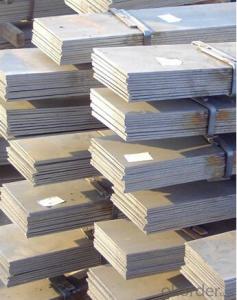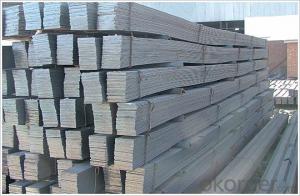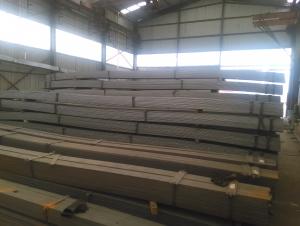Mild Carbon Steel Flat Bar
- Loading Port:
- China Main Port
- Payment Terms:
- TT or LC
- Min Order Qty:
- -
- Supply Capability:
- 10000 m.t./month
OKorder Service Pledge
OKorder Financial Service
You Might Also Like
Specification of Carbon Steel Flat Bar
Commodity: Carbon Steel Flat Bar
Standard: GB, JIS, ASTM,
Material: Q235, SS400 or Equivalent
Origin place: China
Thickness: 3mm-30mm
Width:20mm-200mm
Length: Max 12m
Certification: SGS/BV
Chemical composition of Q235
Alloy No | Grade | Element(%) | ||||
C | Mn | S | P | Si | ||
Q235 | B | 0.12—0.20 | 0.3—0.7 | ≤0.045 | ≤0.045 | ≤0.3 |
Physical properties of Q235
Alloy No | Grade | Yielding strength point(Mpa) | Tensile strength (Mpa) | Elongation after fracture(%) | ||||||
Thickness (mm) | Thickness (mm) | |||||||||
≤16 | >16--40 | >40--60 | >60--100 | ≤16 | >16--40 | >40--60 | >60--100 | |||
≥ | ≥ | |||||||||
Q235 | B | 235 | 225 | 215 | 205 | 375--500 | 26 | 25 | 24 | 23 |
Usage/Applications of Carbon Steel Flat Bar
Widely used for construction;
Machinery manufacturing;
Iron tower steel structure;
Shipbuilding; Steel grating;
Staircase;
Bridge;
Viaduct;
Railway spare parts;
Boilers making etc.
Packaging & Delivery of Carbon Steel Flat Bar
Packaging Details: The Steel Flat Bars are packed in bundles and loaded in 20 feet/40 feet container, or shipped by bulk cargo ,also we can do as customer's requirements.
Delivery Details:30~45 days upon the receipt of buyer payment by T.T. or L/C.
Production Flow of Carbon Steel Flat Bar
The Carbon Steel Flat Bar is made through three processes:
1.Feeding the material: Feeding the row material (the steel plate) to Slitting Line.
2.Slitting:The steel plate would be slitted into expected width by lengthways cutter.
3. Leveled and cutting: The plat bar would be ground into level by the grinder and then cut into required length.
FAQ:
Q1: What makes stainless steel stainless?
A1: Stainless steel must contain at least 10.5 % chromium. It is this element that reacts with the oxygen in the air to form a complex chrome-oxide surface layer that is invisible but strong enough to prevent further oxygen from "staining" (rusting) the surface. Higher levels of chromium and the addition of other alloying elements such as nickel and molybdenum enhance this surface layer and improve the corrosion resistance of the stainless material.
Q2: Can stainless steel rust?
A2: Stainless does not "rust" as you think of regular steel rusting with a red oxide on the surface that flakes off. If you see red rust it is probably due to some iron particles that have contaminated the surface of the stainless steel and it is these iron particles that are rusting. Look at the source of the rusting and see if you can remove it from the surface.
Q3: Why buy Materials & Equipment from OKorder.com?
A3: All products offered byOKorder.com are carefully selected from China's most reliable manufacturing enterprises. Through its ISO certifications, OKorder.com adheres to the highest standards and a commitment to supply chain safety and customer satisfaction.
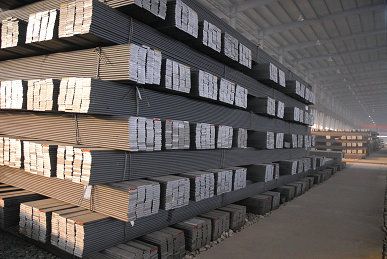
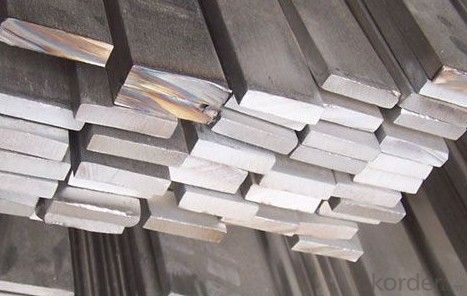

- Q:Are steel flat bars susceptible to rusting?
- Yes, steel flat bars are susceptible to rusting because they are made primarily of iron, which is prone to oxidation when exposed to moisture and oxygen in the environment.
- Q:What is the price range of steel flat bars?
- The price range of steel flat bars can vary depending on various factors such as size, grade, and supplier. However, generally speaking, steel flat bars can range in price from around $10 to $50 per bar.
- Q:What does QB stand for in Q235B flat steel? What's the difference between Q235B and Q235A?
- Low alloy steel Q235A and Q235B in A, B is the difference between the level of quality (total seems to be divided into four levels, you can check and confirm), the main difference is whether it is necessary to do the normal impact test, A does not need to do, need to do B.
- Q:Can steel flat bars be used for tool and die making?
- Yes, steel flat bars can be used for tool and die making. Steel flat bars are commonly used in tool and die making due to their high strength, durability, and versatility. They can be easily machined and shaped into various tooling components such as dies, punches, and molds, making them an ideal material choice for this application.
- Q:Are steel flat bars commonly used in the furniture industry?
- Yes, steel flat bars are commonly used in the furniture industry. They are often used as a structural component in various types of furniture such as tables, chairs, and shelving units. Steel flat bars provide strength and stability to furniture pieces, making them a popular choice in the industry.
- Q:How are steel flat bars stored or transported?
- Steel flat bars are typically stored in bundles or stacks in warehouses or storage yards. They are often bundled together using steel straps or wires to prevent them from shifting during transportation. When transported, flat bars are loaded onto trucks or trailers and secured with straps or chains to ensure they remain in place during transit.
- Q:What are the safety precautions when working with steel flat bars?
- To ensure a safe working environment and prevent injuries when handling steel flat bars, it is crucial to adhere to specific safety precautions. The following are some key guidelines to consider: 1. Personal Protective Equipment (PPE): It is essential to wear the necessary PPE, including safety goggles, gloves, steel-toed boots, and a hard hat. These items provide protection against potential hazards like flying debris, sharp edges, and falling objects. 2. Proper Lifting Techniques: Since steel flat bars can be heavy, it is important to employ correct lifting techniques to avoid strain or injury. Bend your knees, maintain a straight back, and utilize your leg muscles to lift the bars. If the bars are excessively heavy, seek assistance or employ lifting equipment. 3. Secure Work Area: Organize and maintain a clean work area that is free from obstacles. This minimizes the risk of tripping or falling while handling steel flat bars. Additionally, ensure the floor is dry to prevent slips and falls. 4. Sharp Edges: Exercise caution when handling steel flat bars due to their sharp edges that can cause cuts or punctures. Use appropriate tools and avoid direct contact with the sharp edges. If necessary, wear protective gloves or wrap the edges with duct tape or rubber for injury prevention. 5. Machinery and Tools: When using machinery or tools, always adhere to the manufacturer's instructions and safety guidelines. Verify that the equipment is in good working condition, properly maintained, and suitable for the task at hand. Utilize guards and safety features provided by the equipment whenever possible. 6. Fire Safety: Steel flat bars are highly flammable when exposed to extreme heat or sparks. Hence, it is crucial to have easily accessible fire extinguishers and adhere to proper fire safety protocols in the work area. 7. Training and Knowledge: Ensure that you have received adequate training on handling and working with steel flat bars. Familiarize yourself with the material's properties, potential hazards, and safe working practices. If uncertain about any aspect, consult a knowledgeable supervisor or expert. 8. Communication and Teamwork: If working as part of a team, maintain effective communication with coworkers to ensure awareness of tasks and potential risks. Clear communication helps prevent accidents and fosters a safe working environment. By adhering to these safety precautions, the risks associated with working with steel flat bars can be minimized, leading to a safer and more productive work environment.
- Q:How do steel flat bars behave under high temperatures?
- Steel flat bars behave differently under high temperatures depending on the specific grade and composition of the steel. However, in general, steel flat bars tend to lose their strength and stiffness when exposed to high temperatures. They may start to deform, buckle, or even melt if the temperature exceeds the steel's melting point. It is crucial to consider these factors when using steel flat bars in high-temperature applications to ensure structural integrity and safety.
- Q:What are the different surface treatments for steel flat bars?
- Some of the different surface treatments for steel flat bars include galvanization, powder coating, painting, and metal plating. These treatments provide varying levels of corrosion resistance, durability, and aesthetic appeal to the steel bars.
- Q:How is steel flat bar manufactured?
- Steel flat bar is manufactured through a series of processes involving the use of raw materials, machinery, and skilled labor. The production starts with the selection of high-quality steel, usually in the form of billets or slabs. These steel pieces are heated to a specific temperature in a furnace to make them malleable. Once the steel reaches the desired temperature, it is passed through a series of rollers in a process called hot rolling. This process involves using massive rotating rollers to shape the steel into a flat bar. The rollers exert high pressure on the steel, gradually reducing its thickness and increasing its length. The steel is continuously passed through the rollers until it reaches the desired dimensions. After hot rolling, the steel flat bar may undergo a process called pickling to remove any scale or impurities on its surface. Pickling involves immersing the steel in a bath of acid, which chemically reacts with and removes the impurities. This step ensures a clean and smooth surface finish. Once the desired surface finish is achieved, the steel flat bar may undergo additional processes like cold rolling or cold drawing. These processes further refine the dimensions and improve the surface quality of the steel. Cold rolling involves passing the steel through rollers at room temperature, while cold drawing involves pulling the steel through a die to reduce its thickness and increase its length. Finally, the steel flat bar may undergo various finishing processes, such as cutting, machining, or surface treatments, depending on the intended application. These processes ensure that the steel flat bar is cut to the required length and its edges are smooth and free from any imperfections. Overall, the manufacturing of steel flat bar involves a combination of heating, rolling, pickling, and finishing processes to transform raw steel into a versatile and widely used construction material.
1. Manufacturer Overview |
|
|---|---|
| Location | |
| Year Established | |
| Annual Output Value | |
| Main Markets | |
| Company Certifications | |
2. Manufacturer Certificates |
|
|---|---|
| a) Certification Name | |
| Range | |
| Reference | |
| Validity Period | |
3. Manufacturer Capability |
|
|---|---|
| a)Trade Capacity | |
| Nearest Port | |
| Export Percentage | |
| No.of Employees in Trade Department | |
| Language Spoken: | |
| b)Factory Information | |
| Factory Size: | |
| No. of Production Lines | |
| Contract Manufacturing | |
| Product Price Range | |
Send your message to us
Mild Carbon Steel Flat Bar
- Loading Port:
- China Main Port
- Payment Terms:
- TT or LC
- Min Order Qty:
- -
- Supply Capability:
- 10000 m.t./month
OKorder Service Pledge
OKorder Financial Service
Similar products
New products
Hot products
Hot Searches
Related keywords
